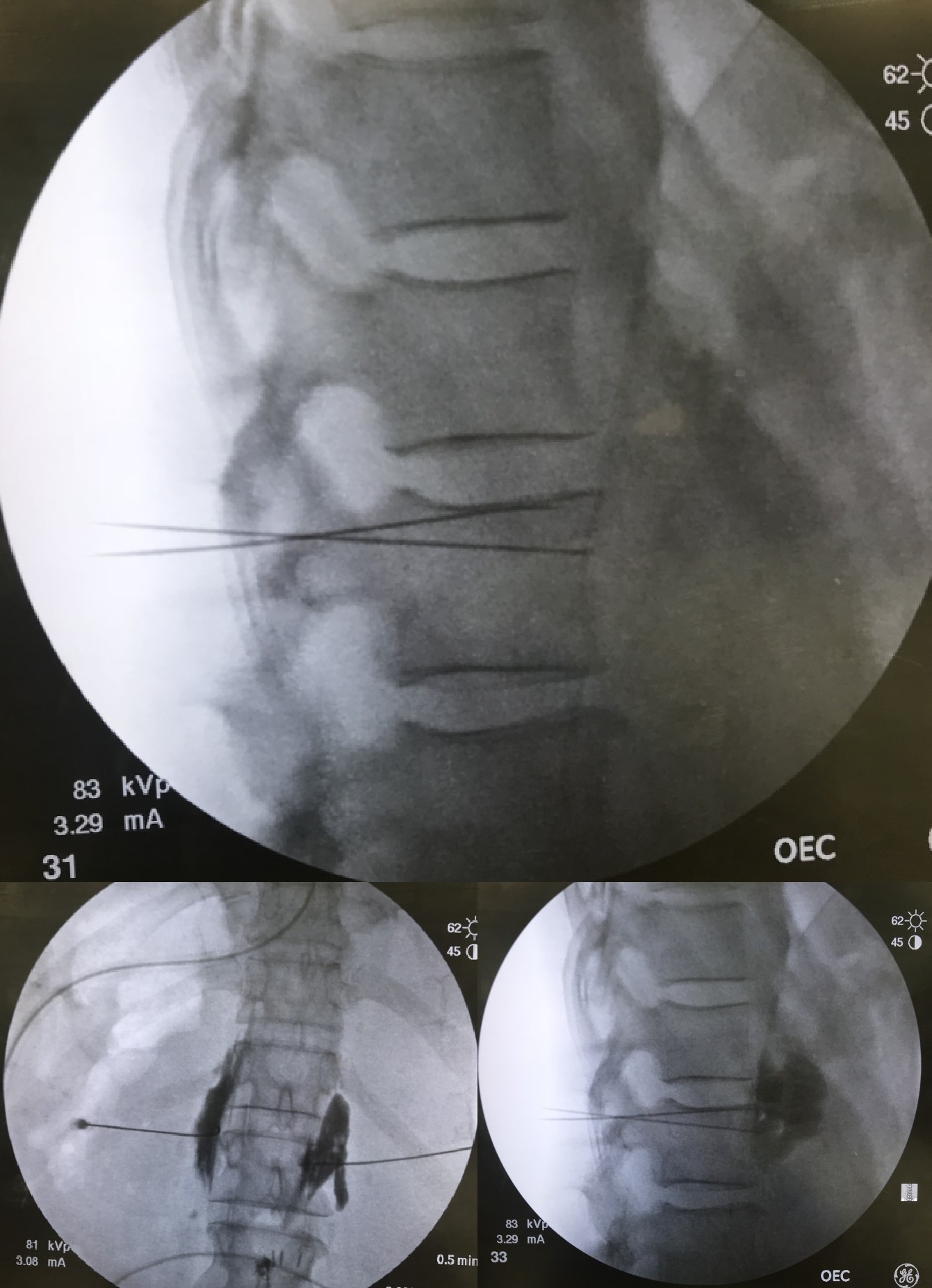[1]
Van Zundert J,Vanelderen P,Kessels A,van Kleef M, Radiofrequency treatment of facet-related pain: evidence and controversies. Current pain and headache reports. 2012 Feb
[PubMed PMID: 22090264]
[2]
Shealy CN, Percutaneous radiofrequency denervation of spinal facets. Treatment for chronic back pain and sciatica. Journal of neurosurgery. 1975 Oct
[PubMed PMID: 125787]
[3]
Loev MA,Varklet VL,Wilsey BL,Ferrante FM, Cryoablation: a novel approach to neurolysis of the ganglion impar. Anesthesiology. 1998 May
[PubMed PMID: 9605700]
[5]
Brown DL,Bulley CK,Quiel EL, Neurolytic celiac plexus block for pancreatic cancer pain. Anesthesia and analgesia. 1987 Sep
[PubMed PMID: 3619093]
[6]
Bosscher H, Blockade of the superior hypogastric plexus block for visceral pelvic pain. Pain practice : the official journal of World Institute of Pain. 2001 Jun
[PubMed PMID: 17129292]
[7]
Ko AL,Ozpinar A,Lee A,Raslan AM,McCartney S,Burchiel KJ, Long-term efficacy and safety of internal neurolysis for trigeminal neuralgia without neurovascular compression. Journal of neurosurgery. 2015 May
[PubMed PMID: 25679283]
[9]
Erdine S, Neurolytic blocks: when, how, why. Agri : Agri (Algoloji) Dernegi'nin Yayin organidir = The journal of the Turkish Society of Algology. 2009 Oct
[PubMed PMID: 20127532]
[11]
Choi EJ,Choi YM,Jang EJ,Kim JY,Kim TK,Kim KH, Neural Ablation and Regeneration in Pain Practice. The Korean journal of pain. 2016 Jan
[PubMed PMID: 26839664]
[12]
Halpern D, Histologic studies in animals after intramuscular neurolysis with phenol. Archives of physical medicine and rehabilitation. 1977 Oct
[PubMed PMID: 907449]
Level 3 (low-level) evidence
[13]
Prologo JD,Gilliland CA,Miller M,Harkey P,Knight J,Kies D,Hawkins CM,Corn D,Monson DK,Edalat F,Dariushnia S,Brewster L, Percutaneous Image-Guided Cryoablation for the Treatment of Phantom Limb Pain in Amputees: A Pilot Study. Journal of vascular and interventional radiology : JVIR. 2017 Jan
[PubMed PMID: 27887967]
Level 3 (low-level) evidence
[14]
van Assen T,Boelens OB,van Eerten PV,Scheltinga MR,Roumen RM, Surgical options after a failed neurectomy in anterior cutaneous nerve entrapment syndrome. World journal of surgery. 2014 Dec
[PubMed PMID: 25189442]
[15]
Ilfeld BM,Gabriel RA,Trescot AM, Ultrasound-guided percutaneous cryoneurolysis providing postoperative analgesia lasting many weeks following a single administration: a replacement for continuous peripheral nerve blocks?: a case report. Korean journal of anesthesiology. 2017 Oct
[PubMed PMID: 29046778]
Level 3 (low-level) evidence
[16]
McCormick ZL,Marshall B,Walker J,McCarthy R,Walega DR, Long-Term Function, Pain and Medication Use Outcomes of Radiofrequency Ablation for Lumbar Facet Syndrome. International journal of anesthetics and anesthesiology. 2015
[PubMed PMID: 26005713]
[17]
Yan BM,Myers RP, Neurolytic celiac plexus block for pain control in unresectable pancreatic cancer. The American journal of gastroenterology. 2007 Feb
[PubMed PMID: 17100960]
[18]
Gofeld M,Jitendra J,Faclier G, Radiofrequency denervation of the lumbar zygapophysial joints: 10-year prospective clinical audit. Pain physician. 2007 Mar
[PubMed PMID: 17387351]
[19]
Lee CH,Chung CK,Kim CH, The efficacy of conventional radiofrequency denervation in patients with chronic low back pain originating from the facet joints: a meta-analysis of randomized controlled trials. The spine journal : official journal of the North American Spine Society. 2017 Nov
[PubMed PMID: 28576500]
Level 1 (high-level) evidence
[20]
Amr SA,Reyad RM,Othman AH,Mohamad MF,Mostafa MM,Alieldin NH,Hamed FA, Comparison between radiofrequency ablation and chemical neurolysis of thoracic splanchnic nerves for the management of abdominal cancer pain, randomized trial. European journal of pain (London, England). 2018 Nov
[PubMed PMID: 29975804]
Level 1 (high-level) evidence
[21]
Streitberger K,Müller T,Eichenberger U,Trelle S,Curatolo M, Factors determining the success of radiofrequency denervation in lumbar facet joint pain: a prospective study. European spine journal : official publication of the European Spine Society, the European Spinal Deformity Society, and the European Section of the Cervical Spine Research Society. 2011 Dec
[PubMed PMID: 21717237]
[22]
Cohen SP,Hurley RW,Christo PJ,Winkley J,Mohiuddin MM,Stojanovic MP, Clinical predictors of success and failure for lumbar facet radiofrequency denervation. The Clinical journal of pain. 2007 Jan
[PubMed PMID: 17277644]
[23]
Juch JNS,Maas ET,Ostelo RWJG,Groeneweg JG,Kallewaard JW,Koes BW,Verhagen AP,van Dongen JM,Huygen FJPM,van Tulder MW, Effect of Radiofrequency Denervation on Pain Intensity Among Patients With Chronic Low Back Pain: The Mint Randomized Clinical Trials. JAMA. 2017 Jul 4
[PubMed PMID: 28672319]
Level 1 (high-level) evidence
[24]
Ferrer-Mileo L,Luque Blanco AI,González-Barboteo J, Efficacy of Cryoablation to Control Cancer Pain: A Systematic Review. Pain practice : the official journal of World Institute of Pain. 2018 Nov
[PubMed PMID: 29734509]
Level 1 (high-level) evidence
[25]
Nagarkar P,Ramanadham S,Chamseddin K,Chhabra A,Rozen SM, Neurectomy for the Treatment of Chronic Postoperative Pain after Surgery of the Trunk. Plastic and reconstructive surgery. 2017 Jan
[PubMed PMID: 28027249]
[26]
Verhagen T,Loos MJA,Scheltinga MRM,Roumen RMH, The GroinPain Trial: A Randomized Controlled Trial of Injection Therapy Versus Neurectomy for Postherniorraphy Inguinal Neuralgia. Annals of surgery. 2018 May
[PubMed PMID: 28448383]
Level 1 (high-level) evidence
[27]
Johner A,Faulds J,Wiseman SM, Planned ilioinguinal nerve excision for prevention of chronic pain after inguinal hernia repair: a meta-analysis. Surgery. 2011 Sep
[PubMed PMID: 21605884]
Level 1 (high-level) evidence

